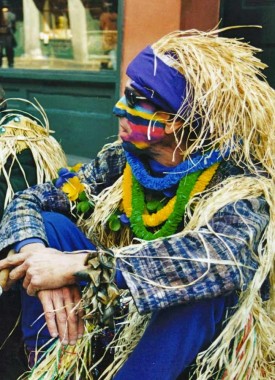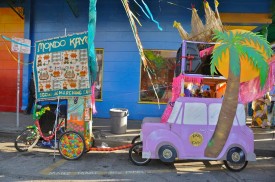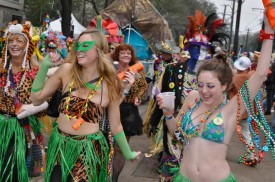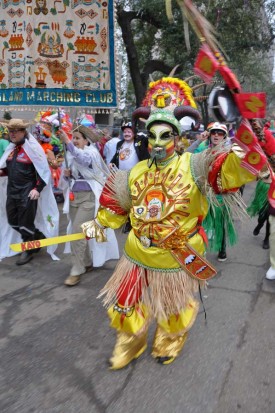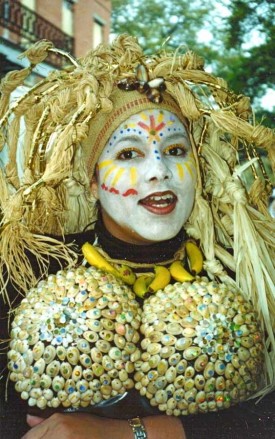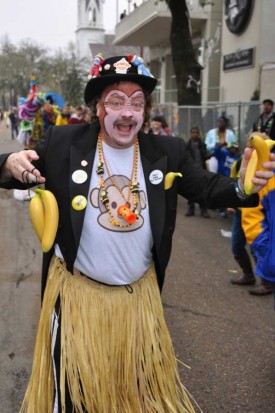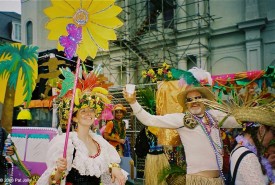As founder, captain and guiding spirit of the Mondo Kayo Social and Marching Club, Chuck Busch, who died of cancer in 2002, left a legacy that continues to delight, amuse and inspire. “It’s a Joseph Campbell, follow-your-bliss thing,” he once said of his progeny, a Fat Tuesday phenomenon that offers visions of tropical abundance and spreads elation through music.
Mardi Gras Maestro
Chuck Busch taking a break
on Fat Tuesday
Driven by an insatiable love of music, he seized on a mythical possibility that was just waiting to happen.—Photo courtesy of Mike Nelson
“For me, the point is to be real loud on Mardi Gras Day,” Chuck Busch explained in a phone conversation before Mardi Gras 1999, “because the music is what Mondo Kayo is really about.”
His krewe, the Mondo Kayo Social and Marching Club, had recently upgraded its sound system with a second pair of high-efficiency PA speakers. Finally, after years of incremental improvements and fine-tuning, everything was close enough to state of the art to satisfy most any fanatic: quiet generator, powerful amplifier, and now killer speakers — all ingeniously incorporated into a bicycle-powered contraption known as the Maxi Taxi. “I don’t know what else to ask for for Mondo Kayo,” Busch said, besides “good weather and no flat tires.”
But alas, when Mardi Gras 2000 came rolling around, an expanded vision of sonic euphoria was dancing in his head — a vision as exotic as some of the music he collected. He spoke of a “parallel sound system” involving two Maxi Taxis positioned a block apart, with the procession of marchers in between. With the right set up, the systems would be akin to separate stereo channels, playing from a single cassette deck. “The preamp coming out would go to this thing that transmits a radio signal, and the preamp-in on the next amp would be the radio signal receiver,” he enthused.
He riffed on the idea a while longer, imagining a spine-tingling sensation of sound coming down the street. “I don’t know if that’s a good idea or not,” he concluded. “But it would be fun to try out, I have to admit.”
If visions of thrilling spectacle are the stuff of Mardi Gras legends, Harvey C. “Chuck” Busch Jr., who died of cancer at age 50 on October 30, 2002, deserves a star on the Mardi Gras Walk of Fame, at the New Orleans Riverside Hilton. As founder, captain and guiding spirit of Mondo Kayo, he left a legacy that continues to delight, amuse and inspire. “They’ve inspired us to get where we are,” says Rodney Ory, a member of the Krewe of Grotesque and Outlandish Habiliments, an up-and-coming Mardi Gras marching club.
The Mondo Kayo Maxi Taxi,
aka Kayo Cab
As music master, Busch had visions of sonic euphoria that were as exotic as some of the music he collected.
Ory remembers first encountering Mondo Kayo in front of Café Brasil, on Frenchmen Street in Fouburg Marigny. Its elaborate rolling sound system made a particularly strong impression. Reflecting on the impetus for his krewe’s evolution from a small contingent of marchers with a boom box and a couple of papier-mache walking heads into an impressive chicken-themed ensemble with elaborate costumes, walking heads, mini floats and a powerful sound system of its own, Ory says, “It all started with seeing Mondo Kayo.”
Mondo Kayo, to be sure, has an aesthetic all its own. Compared to mainstream parades, which tend to be highly organized and prepackaged, Mondo Kayo is footloose and rambunctious — a tribal free-for-all. Their (mostly homemade) regalia is generally tropically themed, but in the spirit of do-it-yourself performance art, individual participants are free to decide for themselves what may please the Tiki gods. And the fact that the krewe operates on the fanciful premise that New Orleans is the northernmost banana republic — backward by some standards yet blessed with tropical abundance — seems to encourage a gonzo mentality whereby participants gleefully embrace “primitive” Bacchanalian impulses. That, and copious quantities of early-morning beer.
How onlookers respond to Mondo Kayo speaks to the exhilarating power of the group’s dynamic. The most telling reactions come from those who are experiencing the spectacle for the first time. Before Mondo Kayo comes along, they are mere spectators, ostensibly biding their time before the Zulu/Rex “main event” — floats, bands and trinkets galore.
Their initial reaction is often bewilderment bordering on shock: “What on Earth…? Who are these… crazies?” Which more often than not turns into pleasant surprise, then elation once they hear the infectious music — featured genres include Soukous, Zouk, Compass, Soca and Exotica — and behold the free-spirited dancing of the Mondo Kayo revelers.
Mondo Kayo revelers
at Mardi Gras 2013
Chanelling the Carnival spirit of joyous license in the “Northernmost Banana republic.”
Pretty soon, everyone’s stoked and juking to the music, and the Carnivalesque spirit begins to feed on itself. Spectators get pulled into the frenzy, sometimes literally, as Mondo Kayo thrives on crowd interaction. And as onlookers are transformed into participants, they become intoxicated with joy.
“You can be a part of it through the music,” says Joe Perez, a Florida resident who first marched with Mondo Kayo in 1997. “All you gotta do is smile and dance, and you’re a part of it.”
On his first outing with Mondo Kayo, Perez remembers feeling as if he’d “floated” down the parade route, buoyed by thrill of making merry with thousands of total strangers. “When it was over it was like, ‘Man, I’m a new person. This was fantastic!’ “ So he kept coming back.
“As far as the elated feeling and the love and energy that is transmitted on that morning,” Perez relates, “there’s nothing that can top that…. On Fat Tuesday, I gotta be marching with Mondo Kayo in New Orleans.”
A blissful soundtrack
Like most Mardi Gras marching groups, Mondo Kayo started out informally and somewhat haphazardly. It was 1982, and Chuck Busch had recently moved to the Irish Channel, in the vicinity of where two marching clubs, the Corner Carnival Club and Pete Fountain’s Half-Fast Walking Club, begin their Mardi Gras sojourns.
Mondo Kayo masker Joe Perez
Bouyed by the thrill of making merry with thousands of total strangers on Mardi Gras 1997, he kept coming back for more.
“The concept was, ‘We should play this great music on Mardi Gras,’ ” he recalled. The musical landscape of Mardi Gras had become infertile — a dead zone between the R&B anthems of the 50s and 60s and the coming wave of brass band revitalization. “ ‘They don’t make Mardi Gras songs in New Orleans, so let’s show ‘em what Mardi Gras music really could be like.’ ”
With a banner and a boom box playing Carnival music from Trinidad and Brazil, Busch and some friends took to the streets. “I think there might have been only eight of us,” he said. “Because I remember saying, ‘If we ever got more than 15, we’d look like a real marching club.’ “ (These days, Mondo Kayo’s ranks number approximately 200.)
From the get go, it was not your typical Mardi Gras marching club. People danced more than they marched, and by the second year there were more women than men. And by using recorded music, Mondo Kayo belied the notion that a marching club without a band is like a New Year’s party without liquor. Indeed, as Busch noted, its whole modus operandi was “the opposite of anything traditional New Orleans.”
The group’s name suggested a melding of the modern (mondo) and primitive (kayo). Busch’s concept of “kayoism” as a sort of intellectual touchstone was formed while passing good times in Mexico. Around 1978, he made a cassette tape for a friend, labeling it “Mondo Kayo.” “That was the first time those words were ever put together,” he would later recall, “and I don’t know why we put the two words together.
“It’s funny. It’s a Joseph Campbell, follow-your-bliss thing.”
As a young man on his way to becoming a prolific American writer on mythology and comparative religion, Joseph Campbell was, according to JosephCampbell.org, a web site dedicated to his work and legacy, “obsessed with the primitive (or, as he later preferred, ‘primal’).” The site goes on to describe him as a devoted scholar and teacher — “not just of cultures long dead, but of living myth, as it made itself known in the world of modern artists and philosophers — individuals who searched within themselves and their societies to identify the need about which they were passionate. He called this burning need that they sought to fulfill their bliss.”
In 1988, “Follow your bliss” became a resonant catch phrase when millions were introduced to Campbell’s ideas by the broadcast on PBS of a series of interviews with Bill Moyers. During one conversation, Moyers asked Campbell if he ever had a sense of “being helped by hidden hands.”
Mondo Kayo reveler
Participants are free to decide for themselves what may please the Tiki gods.—Photo courtesy of Mike Nelson
“All the time,” Campbell replied. “It is miraculous. I even have a superstition that has grown on me as a result of invisible hands coming all the time — namely, that if you do follow your bliss you put yourself on a kind of track that has been there all the while, waiting for you…. When you see that, you begin to meet people who are in your field of bliss, and they open doors to you. I say, follow your bliss and don’t be afraid, and doors will open where you didn’t know they were going to be.
Campbell once wrote, “Myths come from the mystical region of essential experience.” With Mondo Kayo, Busch and his cohorts invented a living myth. In retrospect, he explained, “I really think we were trying to create a myth, a modern myth to define our existence.”
Following his bliss, Busch eventually came to realize that, a la Campbell, the “track” had been there all the while, waiting to happen.
“It’s almost like you create something, and you think you have a plan for it. But you look back and say, ‘How could we not have done what we did?’
“We had to exist, that’s how I look at it. The time was right for our generation to have a marching club.”
“Follow your bliss” became the club’s thematic mantra. For Mardi Gras 1997, the message on Mondo Kayo’s trademark wooden doubloons read: “Wherever you go/Follow your bliss/There you are.”
A tropical bounty in the northernmost
banana republic
Central to the Mondo Kayo mythos is the idea that New Orleans, as the northernmost banana republic and the most exotic city in North America, basically has a lock on kayoism. Cities like Los Angeles, Chicago, Atlanta and Boston, Busch said, “are too modern and sophisticated for kayoism.”
Going bananas with Mondo Kayo
on Fat Tuesday
Banana regalia, props, songs and libations are key to the krewe’s tropical aesthetic.
Bananas are the club’s preeminent motif. Marchers have been known to carry stalks with painted bananas, and leaves from banana trees are used for all manner of decorative embellishment. As well, there’s a banana float that was originally constructed for a queen of the Mystic Orphans and Misfits (MOMs), who rode it for her grand entrance into the captain’s party preceding the krewe’s notoriously raucous ball.
Every year before Mardi Gras, Busch would venture to a secret place downriver from the French Quarter, in the Ninth Ward, to cut bananas and leaves. “Somehow, bananas grow better when it’s more dangerous,” he said, adding that the Ninth Ward is “the most tropical-feeling…Third-World place in town.”
It became a Mondo Kayo tradition to play banana songs and prepare for the mayor a special basket laden with bananas painted gold. When Sidney Barthelemy was mayor, Busch began playing a pre-recorded toast when the krewe arrived at Gallier Hall, where Barthelemy would preside as the city’s official Mardi Gras emcee. It would go something like this:
“Ola, Sidney Barthelemy. Mondo Kayo salutes you and gives thanks for all the rain and sunshine you have brought to our banana trees to make them prosper. As leader of the northernmost banana republic, Mondo Kayo would like to offer you this basket of tropical abundance in symbolic recognition of all that is and will be kayo.”
According to Busch, Barthelemy, who was mayor from 1986 to 1994, thought Mondo Kayo hailed from Latin America. He would offer a toast in return: “Zulu has its coconuts, Mondo Kayo has its golden bananas. From one banana republic to another, I salute you, Mondo Kayo.”
At their best, the toast antics can come off as surreal. In 1997, Mayor Marc Morial, presiding at Gallier Hall, was recognizing Mondo Kayo when Busch brazenly interrupted him in mid-sentence by blasting a recording of a Chiquita banana commercial, circa 1947. As if on cue, the krewe stepped lively into a hula groove and proceeded on their merry way, leaving onlookers slack-jawed.
Over the years, Mondo Kayo’s toast production became increasingly slick. For background, Busch recorded a song by Martin Denny with birdcalls. As described in the liner notes to Exotica! The Best of Martin Denny, his music reveals “visions of beatific Tiki nirvana.”
In a phone conversation before Mardi Gras 1999, Busch was excited about the latest toast tape. Engineered using a new mixer, it was “just weirder and off the wall and wild.” The audio didn’t stop and start between segments, as it had on previous tapes, but faded in and out.
“It starts off scary, like it really is frightening,” he related. “Then it gets tropical, and then it gets hilarious. Then after we toast, there’s all this really weird music that comes with screaming and jungle shouting. It’s ridiculous…pure Exotica, off a brand new CD that came out a few weeks ago.”
Busch had many fond recollections of the years before Mondo Kayo went “legit” and procured a parade permit. He loved the fact that city dignitaries would officially recognize Mondo Kayo, an unauthorized assemblage masquerading as an official marching club on the city’s official parade route.
“Not having a permit and going down and not knowing if you’re going to be able to parade on the route, was a riot of a good time,” he said. “And toasting the mayor without a permit was a riot and getting onto Canal Street without a permit was a riot.”
Renegade revelers and
the trappings of legitimacy
Mardi Gras 1996 marked a turning point. It all began when marching clubs were blamed for holding up the Rex parade. According to a report in the Times-Picayune, the captain of Rex complained to the police commander that the clubs were drinking and socializing with the crowds, delaying His Majesty Rex’s arrival at Gallier Hall. (The real reason for the delay was that Zulu was running late.)
Three official marching clubs, including the city’s oldest, the Jefferson City Buzzards, were waiting to step in behind Zulu just before Lee Circle when policed yanked them from the route. Mondo Kayo was also ejected, but managed to cut back onto the route below Lee Circle.
The crackdown forced a realization that unless Mondo Kayo went through the motions and obtained a permit, its ability to continue parading on the St. Charles Avenue, and thus be part of the main event, would always be in jeopardy. With so much at stake, Mondo Kayo could no longer fly by the seat of its grass skirts.
In Jackson Square, Mardi Gras 2003
Despite the trappings of legitimacy, the krewe is still very much a gonzo, grassroots affair. —Photo ©Pat Jolly
For a group that prided itself on a certain amount of disorganization, catering to officialdom wasn’t easy. Under the section of the city code covering Mardi Gras, only five marching clubs — the Jefferson City Buzzards, Lyons Carnival Club, Corner Carnival Club, Half-Fast Walking Club and Zig-Zag Marching Club — were permitted to parade on Fat Tuesday. Zig-Zag had doppped out of the lineup. However, allowing Mondo Kayo to take its place would require a vote by the City Council to amend the code.
When Busch and several cohorts went before the Mayor’s Mardi Gras Coordinating Committee — a body comprised mainly of city officials and officers of the krewes whose parades make up the city’s “official” Mardi Gras schedule — two things about Mondo Kayo immediately drew red flags. One was that its membership was open to the public: basically, anyone who showed up could march. That flew in the face of the tradition of Mardi Gras krewes having an invited membership. The other was that Mondo Kayo didn’t have mandatory membership dues. Busch and several others would dig into their own pockets to cover expenses, hoping to recoup when “members” showed up to parade.
The committee, nevertheless, ultimately decided to recommend approval to the City Council after Mondo Kayo agreed to adopt a “real” organizational structure, which meant incorporating as a nonprofit and adopting a set of bylaws. “That doesn’t mean a whole lot,” says Jim Cripps, a member of Mondo Kayo who was involved in the proceedings, “because one of the bylaws is that we can change the rules anytime we want to.”
To conjure the impression that it was committed to mending its renegade ways, the krewe had a detailed, lawyerly document drawn up to present to the City Council, spelling out the new regimen. At the council meeting, Busch bumped into the city’s chief administrative officer, Marlin Gusman. They were mutually acquainted through professional circles — Busch was a federal bankruptcy lawyer — and Gusman, after asking Busch why he was at the meeting, offered to make the presentation to the council.
Cripps, an architect, had already lined up support from Councilman Troy Carter. (At the time, he was working for the Vieux Carré Commission, which oversees historic preservation in the French Quarter, part of Carter’s district.) The wife of another Mondo Kayo member put in a good word with a friend, Councilwoman Peggy Wilson. Although typically at odds with Carter, who brought forward the motion to approve a permit for Mondo Kayo, she, too, lent her support. The council voted to approve the permit.
In retrospect, it was a heck of a coup. Given the prevailing attitude among city officials and the police, who see the marching groups as a source of headaches, there’s about as much of a chance of a newcomer obtaining a Fat Tuesday permit as there is of seeing a revived Comus parade roll down Bourbon Street.
Perhaps inevitably, the trappings of legitimacy, which include marching with a police escort, gave rise to nostalgia for the Mondo Kayo’s pre-permit exploits, albeit tinged with a delicious sense of irony. Busch likened the state of affairs to “Grateful Dead Inc.” — standard-bearers of the counterculture who went mainstream.
“Now we’ve got a committee,” he said incredulously, adding: “It’s weird. We make decisions legitimately.”
Core operatives were in some ways relieved to share power and delegate responsibility, but there was never any question that music would remain the captain’s prerogative.
Chuck Busch had an insatiable love of music. Collecting binges were the frequent result of discovering a new genre, and he loved to share his passions through Mondo Kayo, online forums and phone conversations with fellow aficionados he met online.
His passing brought fourth an outpouring of praise and remorse in an online forum devoted to Exotica. One posting observed that obsession with music, when it reached a certain level, could be “just a bit creepy, but with Chuck it was never like that. He was like an enthusiastic kid, and you couldn’t help but enjoy his enthusiasm.”
Mondo Kayo was like a mirror and compass, reflecting the shifting tangents of Busch’s discoveries and enthusiasms. Selections could range from Caribbean and Latin American Carnival tunes to surf music, space-age bachelor pad music and acid jazz.
While much of what he recorded for Mondo Kayo would never have been heard before by the average person in the street — music from Angola, Zaire, Martinique, Haiti, Trinidad, Brazil, Peru and Uruguay — he couldn’t resist mixing in the occasional spaghetti western tune, such as the theme from Rawhide (“Rollin’, rollin’, rollin…Keep them dogies rollin’ ”). He once described such fare as “little breaks that you need for the zaniness of the mondo world.”
“I know one thing,” he said: “Without music, we would no longer be Mondo Kayo. We might be kayo, but we wouldn’t be Mondo Kayo.”
MardiGrasTraditions.com

